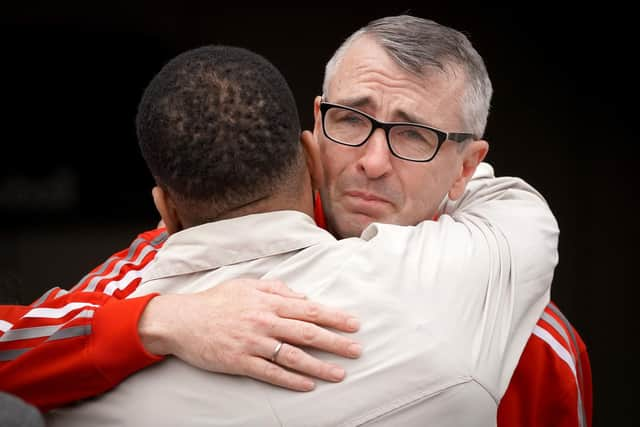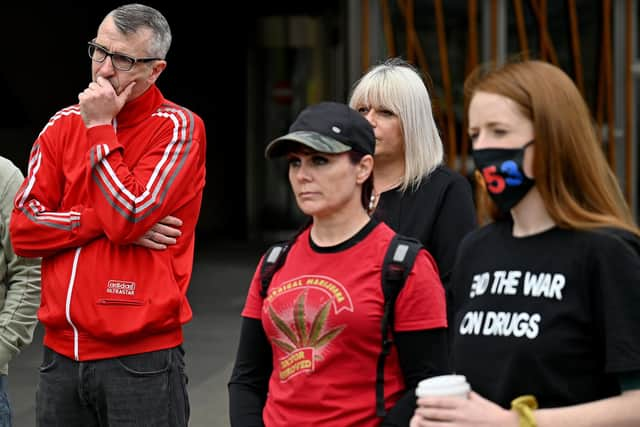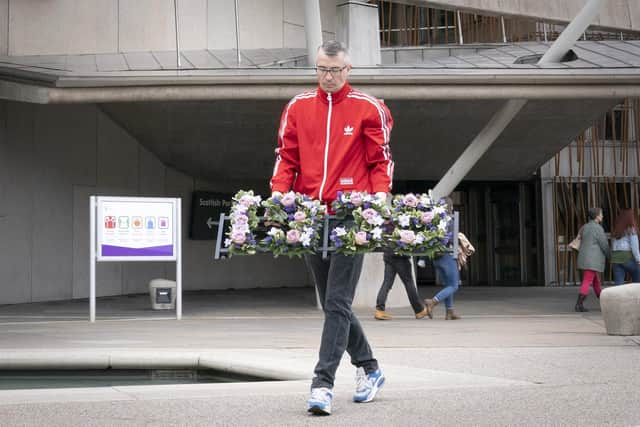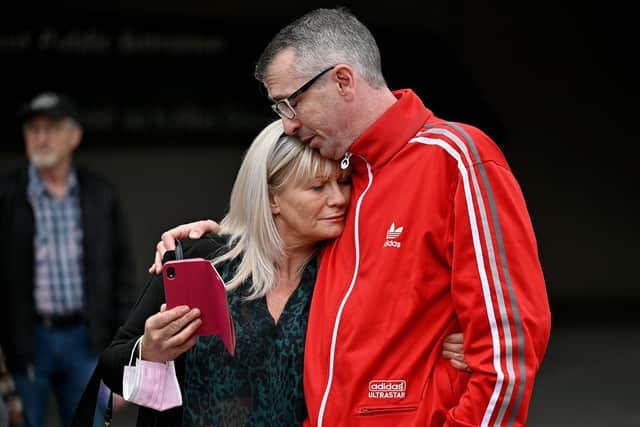'It was incredibly scary. I didn't want to die': Drugs campaigner Peter Krykant opens up on relapsing
and live on Freeview channel 276
“He was asking for advice on girlfriends – the usual. He was a bit of a ladies man.”
Callum died in July 2020 at the age of 24.
His was one of 1,339 lives lost to drugs in Scotland last year.


Advertisement
Hide AdAdvertisement
Hide AdThe relatives are here on Tuesday as an act of remembrance. They want to mourn their losses free from stigma, but they also want to draw attention to the scale of the country’s crisis.
Before speaking, Ms Woods had helped lay a wreath that picked out the grim toll in flowers. That toll has risen every year for the past seven years.
Scotland’s per capita drug death rate is now three-and-a-half times that of any other European country.


Ms Woods is in tears as she talks about her brother, who had an abusive childhood and probably suffered from ADHD. “Callum was loved by so many,” she says. “He was popular. But he found lockdown very difficult.“
Advertisement
Hide AdAdvertisement
Hide AdOn either side of the wreath are photographs of Jamie Walton. In one of them, he is holding his baby son; he looks healthy and happy. He died in 2016.
Mr Walton had been on drugs on and off for eight or nine years.
“Jamie started off smoking cannabis, then tried harder and harder drugs until he was smoking heroin and then injecting it,” his mum Margaret Roach says.


“I tried to help him, went to meetings with him. He tried hard to give them up.”
Advertisement
Hide AdAdvertisement
Hide AdMr Walton had always wanted to be a dad and doted on his wee boy. “He came off the drugs after he was born,” Ms Roach says. “But then his best friend went into a diabetic coma and had to have his life support switched off.”
Jamie died ten weeks later. He was 31.


In his years of addiction, Mr Walton had come close to dying many times. On those occasions he had been saved by Naloxone, the antidote to an opioid overdose.
On the opposite side of the road sits a former ambulance, converted into a mobile drugs consumption room (DCR) by activist Peter Krykant, who organised this Holyrood event.
It is exactly a year since Mr Krykant, a former heroin addict, first took his mobile DCR to Parnie Street in Glasgow and opened its doors to street injectors – an act police and the Scottish Government claimed was illegal.
Advertisement
Hide AdAdvertisement
Hide AdMuch has happened since. As the drug deaths continued to rise, Mr Krykant was transformed from a bête noire of the establishment to a man whose expertise is sought by policy-makers – although the legality of the van is still contested.
He stood unsuccessfully as an independent MSP for Falkirk East in May’s election.
But working on the frontline took its toll. A few weeks after the election, Mr Krykant relapsed.
On May 31, he collapsed, waking up hours later. He knows how close he came to becoming one of this year’s statistics.
Advertisement
Hide AdAdvertisement
Hide AdThose few weeks were horrendous. Mr Krykant hadn’t used drugs for 11 years. In the past, he had taken pharmaceutical benzodiazepines.
But now, for the first time, he encountered the street benzos, which are at the heart of Scotland’s emergency.
“It was incredibly scary,” he says. “I didn’t want to die. I was just trying to get rid of some of that unresolved pain. But every time you took them you didn’t know what the impact would be.”
Mr Krykant also experienced first-hand the difficulties users have in getting help.
Advertisement
Hide AdAdvertisement
Hide Ad“My life was imploding,” he says. “The day after I almost overdosed, I contacted the local services and told them ‘I nearly died yesterday, I am desperate for help’ and their response was they could give me a telephone assessment in ten days’ time.”
What Mr Krykant wanted was a prescription for buprenorphine, an alternative to methadone, so he could stabilise and then detox in the community.
The new Medication Assisted Treatment (MAT) standards, which should be implemented by next April, include same-day prescription. But Mr Krykant waited several weeks.
“After the telephone assessment I had to wait a further eight days for a face-to-face assessment,” he says. “Then, there were two separate drug screening tests, and a liver function test, before I finally got it.”
Advertisement
Hide AdAdvertisement
Hide AdHe had been taking it for two days when someone offered to pay for rehab in England.
Mr Krykant is in recovery again now, but the experiences of the past year have left him emotionally raw. He was so upset reading out a message from a bereaved relative, he had to hand over to someone else.
Since the announcement of the 2019 figures last December, there have been some changes.
The Scottish Government appointed a new dedicated drugs policy minister, Angela Constance, and pledged £50 million a year for the next five years to be split between harm reduction and recovery initiatives.
Advertisement
Hide AdAdvertisement
Hide AdBut Mr Krykant says – given the slow pace of progress – he is not optimistic the figures will drop significantly.
“It is disheartening that the death rates are still so high,” he says. “Part of Overdose Awareness Day is to stimulate conversation around drug policy.”
Politicians have turned out to pay their respects. Ms Constance is there, along with Scottish Labour leader Anas Sarwar and new Scottish Conservative drugs spokesperson Sue Webber.
Ms Constance acknowledges the scale of the crisis.
“What struck a chord with me is that the Highlands is the area of Scotland that has the lowest rate of drug-related deaths, but that is still higher than the worst area in England, which is Newcastle and the North-East,” she says.
Advertisement
Hide AdAdvertisement
Hide AdShe also acknowledges treatment is still not available quickly enough. “What happened to Peter is not acceptable,” she says. “It is absolutely key that when people ask for help that they get it and they get it quickly.
“[Through the MAT standards] we are turning round a system away from a three-week waiting time to a system of same-day prescribing. We are not there yet, but that’s an absolute goal and I am determined to get there.”
Ms Constance says the Scottish Government is exploring drug checking services, which allow samples to be tested for potency and purity.
“I am committed to drug checking facilities, but they do require a Home Office licence,” she says. Researchers at Stirling University are looking at possible projects in Dundee, Aberdeen and Glasgow.
Advertisement
Hide AdAdvertisement
Hide AdMr Sarwar said he had come to show solidarity with the relatives.
“You hear lots of warm words from politicians when it comes to the annual publication of the drug deaths statistics, but we have to back that with meaningful action,” he says.
“I think you can see today that behind the big number are real people. Drug deaths impact whole families, whole communities.”
As the event comes to a close, the MSPs and journalists drift away, leaving the rose petals scattered by relatives floating on the reflection pool.
Comment Guidelines
National World encourages reader discussion on our stories. User feedback, insights and back-and-forth exchanges add a rich layer of context to reporting. Please review our Community Guidelines before commenting.
